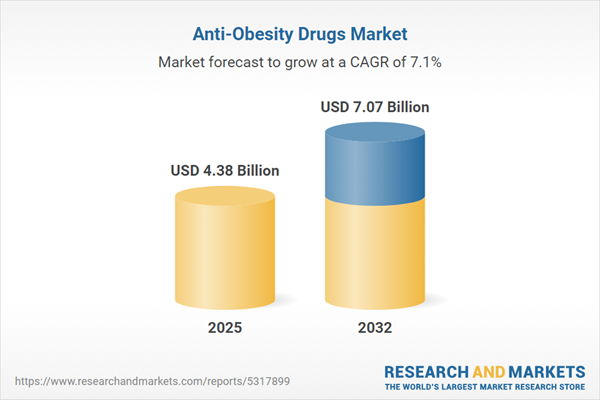Speak directly to the analyst to clarify any post sales queries you may have.
The anti-obesity drugs market is evolving rapidly, with senior leaders facing new demands to adapt in a shifting regulatory, technological, and operational landscape. Strategic foresight and preparedness are now essential for sustaining a competitive edge.
Market Snapshot: Anti-Obesity Drugs Market Growth Trajectory and Trends
The anti-obesity drugs market is projected to grow from USD 4.09 billion in 2024 to USD 4.38 billion in 2025 and is expected to reach USD 7.07 billion by 2032, delivering a compound annual growth rate (CAGR) of 7.06%.
This trajectory is shaped by rising demand for targeted therapies, robust pharmaceutical investment, and the steady emergence of novel treatments. Ongoing R&D achievements and the increasing occurrence of obesity worldwide are driving clinical innovations and creating new opportunities for industry collaboration. Adoption of digital health is streamlining operations, supporting innovative care models, and enabling stakeholders to uncover opportunities through regulatory adaptability.Scope & Segmentation of the Anti-Obesity Drugs Market
- Product Types: GLP-1 agonists, naltrexone bupropion, orlistat, phentermine topiramate, SGLT2 inhibitors, combination therapies, and new-generation agents are expanding treatment options and advancing therapeutic platforms.
- Dosage Forms: Capsules, injectables, tablets, prefilled pens, and vials support flexible administration to meet diverse patient needs and settings.
- Routes of Administration: Injectable, oral, prefilled autoinjector, and nasal forms enhance accessibility across institutional, clinical, and home-based care.
- End Users: Hospitals, clinics, and homecare organizations are integrating anti-obesity therapies into broader healthcare pathways, from outpatient services to community health programs.
- Regions: The Americas, Europe, Middle East and Africa, and Asia-Pacific require tailored compliance, reimbursement, and distribution approaches to reflect distinct policy environments and market dynamics.
- Key Companies: Novo Nordisk A/S, Eli Lilly and Company, Pfizer Inc., AstraZeneca PLC, Boehringer Ingelheim International GmbH, Amgen Inc., Zealand Pharma A/S, Gelesis, Inc., F. Hoffmann-La Roche AG, and GlaxoSmithKline plc are continually shaping the competitive landscape through innovation and strategic consolidation activities.
This comprehensive segmentation enables organizations to focus resources effectively, streamline regulatory compliance, and adapt product positioning for growth across different markets. Increasing integration of digital technologies into therapeutic delivery and patient management is reinforcing the drive for personalized solutions and operational gains. Navigating diverse regional regulatory landscapes also empowers companies to optimize distribution and market access, crucial for sustained sector presence.
Key Takeaways for Senior Decision-Makers
- GLP-1 agonists are transforming care pathways, requiring alignment of clinical infrastructure and resources to support their incorporation into healthcare systems.
- Expansion of digital health platforms, including remote patient monitoring, is improving adherence and broadening access beyond conventional care settings.
- Increased regulatory scrutiny means that robust risk management and process improvements are essential throughout the product lifecycle to sustain compliance and safety.
- Value-based care models are placing greater emphasis on clinical and cost-effectiveness evidence, with impacts on payer decisions and organizational priorities.
- Diverse regional policies highlight the importance of localized market entry and compliance strategies for maintaining leadership and responding to varied reimbursement frameworks.
- Building cross-industry partnerships for supply chain resilience is becoming essential to address operational disruption and ensure consistent product availability amid ongoing change.
Tariff Impact: Navigating Policy Shifts and Global Supply Chains
With new tariffs expected for 2025, companies are reevaluating sourcing and supplier networks. Moving toward near-shoring and forging local partnerships is minimizing disruption by reinforcing supply continuity and supporting profitability through unpredictable regulatory and market conditions.
Methodology & Data Sources in the Anti-Obesity Drugs Market
This analysis synthesizes information from peer-reviewed publications, regulatory standards, diverse industry perspectives, and patient advocacy organizations. These input sources collectively provide a foundation for objective market insight and sound strategic recommendations.
Why This Report Matters
- Delivers executive-oriented forecasting and scenario analysis, equipping decision-makers to act quickly and confidently in the changing anti-obesity drugs market.
- Integrates leading perspectives on regulation, technology, and clinical development, supporting robust risk controls and ongoing business development.
- Facilitates regional benchmarking and supports the creation of strategies that build resilience and agility in fluctuating market conditions.
Conclusion
Success in the anti-obesity drugs market requires agility, collaboration, and data-driven strategies. Organizations leveraging advanced insights will be well-positioned to secure new opportunities while maintaining operational strength.
Additional Product Information:
- Purchase of this report includes 1 year online access with quarterly updates.
- This report can be updated on request. Please contact our Customer Experience team using the Ask a Question widget on our website.
Table of Contents
3. Executive Summary
4. Market Overview
7. Cumulative Impact of Artificial Intelligence 2025
Companies Mentioned
The companies profiled in this Anti-Obesity Drugs market report include:- Novo Nordisk A/S
- Eli Lilly and Company
- Pfizer Inc.
- AstraZeneca PLC
- Boehringer Ingelheim International GmbH
- Amgen Inc.
- Zealand Pharma A/S
- Gelesis, Inc.
- F. Hoffmann-La Roche AG
- GlaxoSmithKline plc
Table Information
| Report Attribute | Details |
|---|---|
| No. of Pages | 188 |
| Published | October 2025 |
| Forecast Period | 2025 - 2032 |
| Estimated Market Value ( USD | $ 4.38 Billion |
| Forecasted Market Value ( USD | $ 7.07 Billion |
| Compound Annual Growth Rate | 7.0% |
| Regions Covered | Global |
| No. of Companies Mentioned | 11 |









